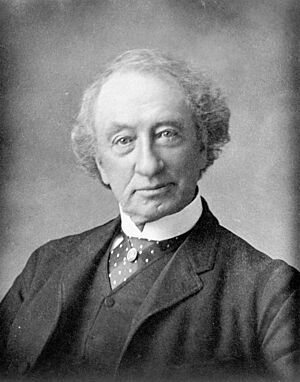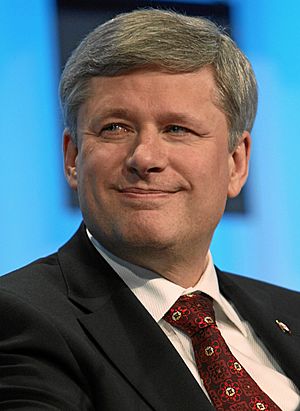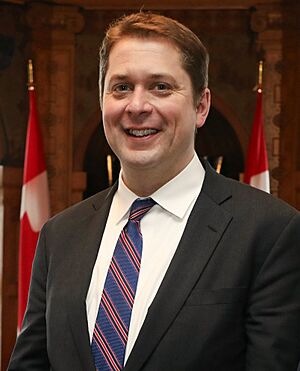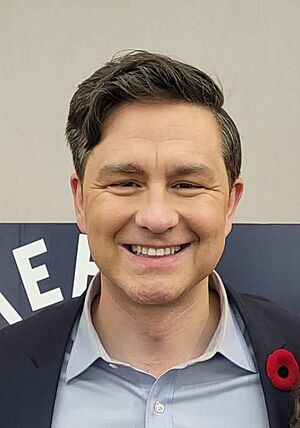Conservative Party of Canada facts for kids
Quick facts for kids
Conservative Party of Canada
Parti conservateur du Canada
|
|
|---|---|
 |
|
| Abbreviation | CPC PCC |
| Leader | Pierre Poilievre |
| President | Stephen Barber |
| Parliamentary leader | Andrew Scheer |
| Deputy leaders |
|
| Senate leader | Leo Housakos |
| Founders | |
| Founded | December 7, 2003 |
| Merger of | Progressive Conservative Canadian Alliance |
| Headquarters | 1800–66 Slater Street Ottawa, Ontario K1P 5H1 |
| Membership (2022) | |
| Ideology |
|
| Political position | Centre-right to right-wing |
| Regional affiliation | Asia Pacific Democracy Union |
| International affiliation | International Democracy Union |
| Colours | Blue |
| Senate |
14 / 105
|
| House of Commons |
143 / 343
|
The Conservative Party of Canada (CPC) is a major federal political party in Canada. It is also known as the Tories. The party was created in 2003 when two other parties, the Progressive Conservative Party and the Canadian Alliance, decided to merge.
In Canadian politics, the Conservative Party is considered to be centre-right to right-wing. This means it generally supports lower taxes, less government spending, and free-market economic policies. Its main rival is the Liberal Party of Canada, which is seen as being more to the centre-left.
The party is often called a "big tent" party. This means it welcomes people with a wide range of conservative ideas.
The Conservatives were the governing party of Canada from 2006 to 2015 under Prime Minister Stephen Harper. After that, they became the Official Opposition, which is the largest party in Parliament that is not in power. The current leader of the party is Pierre Poilievre.
Contents
History of the Party
The roots of the Conservative Party go back to the 1800s. Canada's first Prime Minister, John A. Macdonald, led a party called the Liberal-Conservatives. This party later became known as the Conservative Party. For many years, it was one of the two main parties in Canada.
A Split on the Right

In the late 1980s, many conservatives in Western Canada felt that the Progressive Conservative Party wasn't representing their interests. They created a new party called the Reform Party of Canada.
In the 1993 election, the Progressive Conservatives lost most of their seats in Parliament. The Reform Party, on the other hand, won many seats in the West. For the next ten years, the conservative vote was split between these two parties. This made it hard for either of them to defeat the Liberals, who were in power.
Coming Together Again
Many people believed that the two conservative parties needed to unite to be successful. In 2003, the leaders of the Canadian Alliance (which the Reform Party had become) and the Progressive Conservatives agreed to merge. They formed the new Conservative Party of Canada.
Not everyone was happy with the merger. Some members from both of the old parties decided not to join the new one. However, the new party quickly became the main opposition to the Liberal government.
The Stephen Harper Years (2004–2015)
Stephen Harper was elected as the first permanent leader of the new Conservative Party in 2004. He led the party in the election that year, where it won 99 seats and became the Official Opposition.
In Government

In the 2006 election, the Conservatives won the most seats and formed a minority government. This means they had more seats than any other party but less than half of the total seats in the House of Commons. They won another minority government in 2008.
In the 2011 election, the party won a majority government. This gave them full control of Parliament. During their time in power, the Harper government:
- Lowered the sales tax (GST) and income taxes.
- Created the Tax-Free Savings Account (TFSA).
- Increased spending on the military.
- Ended the long-gun registry, a database of certain firearms.
- Withdrew Canada from the Kyoto Protocol, an international climate agreement.
In the 2015 election, the Conservatives were defeated by the Liberal Party, led by Justin Trudeau. Stephen Harper resigned as leader of the party after the election.
In Opposition (2015–Present)
After 2015, the Conservative Party became the Official Opposition again. Rona Ambrose served as the interim leader until a permanent leader was chosen.
Andrew Scheer (2017–2020)

In 2017, Andrew Scheer was elected as the new leader. He led the party into the 2019 election. The Conservatives won more votes than any other party but did not win the most seats. The Liberals formed another government, and the Conservatives remained the opposition. Scheer resigned as leader in 2020.
Erin O'Toole (2020–2022)

Erin O'Toole won the leadership election in August 2020. He tried to move the party more towards the political centre. He led the party in the 2021 election. The results were very similar to the 2019 election, with the Liberals winning another minority government.
In February 2022, Conservative Members of Parliament voted to remove O'Toole as leader.
Pierre Poilievre (2022–Present)

On September 10, 2022, Pierre Poilievre was elected as the new leader of the party. He won with a large majority on the first ballot.
Poilievre led the party into the 2025 federal election. The Conservatives increased their number of seats and won over 40% of the popular vote for the first time. However, they did not win enough seats to form a government and remained the Official Opposition. Poilievre also lost his own seat in his riding of Carleton. Despite this, he remained as party leader.
What the Party Believes In
The Conservative Party has a wide range of ideas, but most are based on conservatism. Here are some of their main principles and policies.
Economic Policy
- Lower Taxes: The party supports reducing taxes for individuals and businesses.
- Balanced Budgets: They believe the government should not spend more money than it collects in taxes.
- Free Markets: They support less government interference in the economy.
- Natural Resources: The party supports the development of Canada's oil and gas industry, including building pipelines.
Social Policy
- Law and Order: The party supports tougher sentences for criminals.
- Immigration: They want an immigration system that is orderly and focuses on bringing in skilled workers.
- Canadian Identity: The party supports protecting Canada's history and traditions, including the monarchy.
Foreign Policy
- Strong Alliances: The party supports Canada's membership in NATO.
- Free Trade: They support trade agreements with other countries.
- Support for Israel: The party is a strong supporter of the state of Israel.
Where the Party is Strongest
The Conservative Party has historically been very strong in Western Canada. It often wins most or all of the federal seats in Alberta and Saskatchewan. The party also has strong support in rural parts of Ontario.
The party is generally weaker in Quebec and Atlantic Canada. It also tends to have less support in large cities like Toronto and Montreal.
Election Results
This table shows how the Conservative Party has performed in federal elections since it was created.
| Election | Leader | Votes | % | Seats | +/– | Position | Status |
|---|---|---|---|---|---|---|---|
| 2004 | Stephen Harper | 4,019,498 | 29.63 |
99 / 308
|
Opposition | ||
| 2006 | 5,374,071 | 36.27 |
124 / 308
|
Minority | |||
| 2008 | 5,209,069 | 37.65 |
143 / 308
|
Minority | |||
| 2011 | 5,832,401 | 39.62 |
166 / 308
|
Majority | |||
| 2015 | 5,578,101 | 31.89 |
99 / 338
|
Opposition | |||
| 2019 | Andrew Scheer | 6,239,227 | 34.34 |
121 / 338
|
Opposition | ||
| 2021 | Erin O'Toole | 5,747,410 | 33.74 |
119 / 338
|
Opposition | ||
| 2025 | Pierre Poilievre | 8,099,549 | 41.27 |
144 / 343
|
Opposition |
Images for kids
See also
 In Spanish: Partido Conservador de Canadá para niños
In Spanish: Partido Conservador de Canadá para niños
- List of federal political parties in Canada
- Predecessor parties:
- Conservative Party of Canada (1867–1942)
- Progressive Conservative Party of Canada (1942–2003)
- Reform Party of Canada (1987–2000)
- Canadian Alliance (2000–2003)



